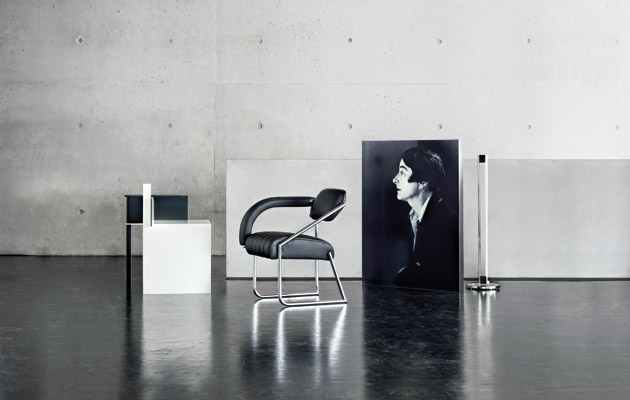|
|
||
|
Few objects show Eileen Gray’s playful, human approach to modernism better than this asymmetrical chair – an elegant response to the restlessness of a seated figure The underlying theme of the Non Conformist chair, by Irish designer Eileen Gray (1878–1976), is comfort. Its tubular frame was designed ergonomically, as Gray understood that the average human has a tendency to sit slightly to one side: “Observe the very distinctive and comfortable form of the chair – one has removed one of the armrests to give greater liberty to the body, which can lean to one side and look or turn to the other without any discomfort.” To this end, one curved armrest was upholstered; the other simply consisted of a slanted chrome steel bar. Gray remains an elusive figure in 20th-century modernism. Born in Enniscorthy, she studied painting at London’s Slade School, yet is now renowned instead as furniture designer and architect. Certain pieces by Gray have become recognisable in modern culture, notably her Adjustable table, while her early lacquer work is currently achieving record prices at auction. Yet the Non Conformist chair has a special place in her oeuvre. Detailed elevations were first illustrated in the winter 1929 issue of the avant-garde journal, L’Architecture Vivante. These reflect Gray’s perfectionism, recording every detail of the textured upholstery. In later drawings, she pursued more exaggerated asymmetry, but in final versions, and in the final chair, she accepted the practicality of these early images. The chair, of which only two survive, was created by Gray for the bedroom of E-1027 (1926–29), the house she designed on the Côte d’Azur for the Romanian architect Jean Badovici. The pair had a troubled relationship – he was a mentor, client, editor, writer and lover, who encouraged her to pursue architecture, but failed to recognise her achievement. The design of E-1027 and its furniture was playful, subtle and carefully attuned to the sun and wind – while Gray had initially been influenced by Le Corbusier’s planar style of modernism, she now integrated architecture and furniture, believing that architecture must be its own decoration. The interior was filled with her lightweight, portable and flexible furniture, able to accommodate a number of activities and exemplifying the “camping style”. Gray created a second version of the chair for the living room at E-1027, specifically for Badovici’s use. Made from nickel, and with navy blue upholstery, it had a slight variation in the design. He had a tendency to rest all of his arm on the rest, so Gray covered its entire length with fabric – her armrest was only partially upholstered as she tended to lean on her elbow. She and Badovici separated shortly after the completion of E-1027, but Gray’s original example of the chair remained in her apartment in the rue Bonaparte in Paris until the end of her life. Despite its idiosyncrasies, the Non Conformist chair was always intended for mass production – Gray briefly sold it herself at her shop on the rue du Faubourg Saint-Honoré. The chair’s distinctive title was reflective of Gray’s personality and mocking spirit, a demeanour that contributed to her own eclipse from the canon of modern design for too many years. The rediscovery of her work in the 1970s has resulted in an increasing admiration for her genius, of which the ingenuity and elegance of the Non Conformist chair is a perfect example. |
Words Jennifer Goff
Above: The second version of the chair, with fully upholstered right arm, designed for Jean Badovici
Image: ClassiCon, courtesy Aram Store |
|
|
||



















